Summary of key points
Jaggery vs Palm Sugar comparison reveals that both are natural sweeteners derived from plant sources but differ in origin and flavor. Jaggery is made from the sap of sugarcane or date palm, known for its rich molasses flavor and dark color. Palm sugar is specifically made from the sap of the sugar palm tree, with a milder caramel-like taste. Nutritionally, both offer more minerals than white sugar but should still be consumed in moderation.
If you’ve ever been to an Indian grocery store or even peeked inside a package of some sort of sweet and savory treats, then you’re likely familiar with the curious ingredient jaggery.
Similarly, palm sugar is becoming increasingly popular in many Asian households.
But what exactly is the difference between jaggery and palm sugar?
Are they interchangeable when it comes to food recipes and applications?
n this blog post, we’ll address all these questions—breaking down their distinct similarities and differences so that you can make a more informed purchasing decision next time you go shopping for either product!

What is Jaggery?
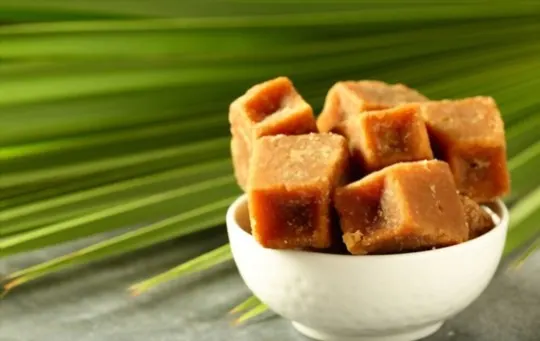
Jaggery is a type of sweetener that is widely used in South Asian and Southeast Asian cuisine.
It is made by boiling sugarcane juice or palm sap until it becomes thick and then leaving it to cool and solidify.
The resulting product has a dark brown color, a coarse texture, and a sweet, earthy flavor.
Jaggery has been used for thousands of years as a natural sweetener in many parts of the world.
This unrefined sugar contains essential minerals like iron, calcium, magnesium, and potassium.
It also provides warmth to the body when consumed during winters.
Jaggery has numerous health benefits such as aiding digestion and improving immunity due to the presence of minerals.
It also helps prevent anemia by increasing hemoglobin levels.
In addition to being used as a sweetener in desserts and snacks like laddoos or chikkis, jaggery is often added to savory dishes like curries and soups to balance out flavors.
What is Palm Sugar?
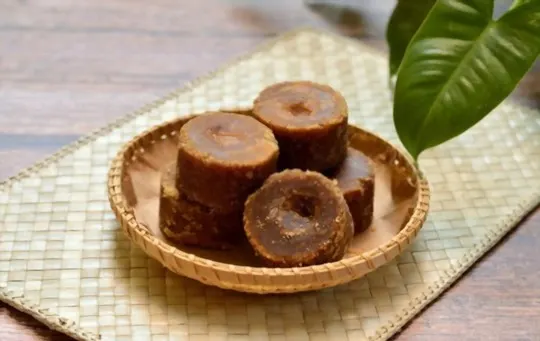
Palm Sugar is a sweetener that is derived from the sap of palm trees.
It is used extensively in Southeast Asian cuisine as well as in various other parts of the world, including India and parts of Africa.
In addition to its use in cooking, Palm Sugar is also used for medicinal purposes and has various health benefits.
Palm Sugar is valued for its numerous health benefits as well, which make it a popular alternative to refined sugar.
Some of these benefits include its ability to help control blood sugar levels, improve digestion, and boost energy levels.
In addition to this, Palm Sugar is low on the glycemic index scale which means it does not cause spikes in blood sugar levels like some other sweeteners do.
Overall, Palm Sugar is a versatile and healthy alternative to processed sugars.
Its unique flavor profile adds complexity to dishes while also providing numerous health benefits.
Differences Between Jaggery and Palm Sugar
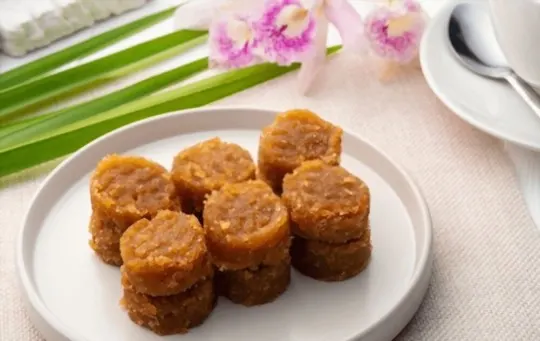
Jaggery and Palm sugar are two widely used alternatives to white sugar that offer various health benefits.
While both of these sugars may seem similar, they have some key differences in terms of their origin, taste, texture, and nutritional value.
As you can see, while jaggery is made from sugarcane juice, palm sugar is extracted from the sap of Palmyra or coconut trees.
This difference in origins translates into variations in taste and texture as well.
Jaggery tends to have a softer consistency while palm sugar is more granulated.
Nutritionally speaking, jaggery contains higher levels of minerals like iron, calcium, and phosphorus compared to palm sugar.
However, palm sugar has a lower glycemic index than jaggery which makes it a better option for those who are trying to regulate their blood glucose levels.
Ingredients Used
To understand the differences between jaggery and palm sugar, it is essential to know the ingredients used in both of these sweeteners.
Jaggery and palm sugar are made from different sources, and thus, their ingredients differ as well.
Jaggery is made by boiling sugarcane juice or date palm sap until it thickens and solidifies.
It doesn’t undergo any bleaching or chemical treatment, making it a healthier alternative to white sugar.
On the other hand, palm sugar is obtained by collecting the sap from various types of palms like coconut, palmyra, etc.
The sap is then boiled until it turns into a golden brown syrup that can be shaped into blocks.
It’s interesting to note that both jaggery and palm sugar are unrefined sweeteners, which means they retain most of their natural vitamins and minerals.
These sweeteners also have a low glycemic index compared to refined white sugar.
Texture and Flavor Comparison
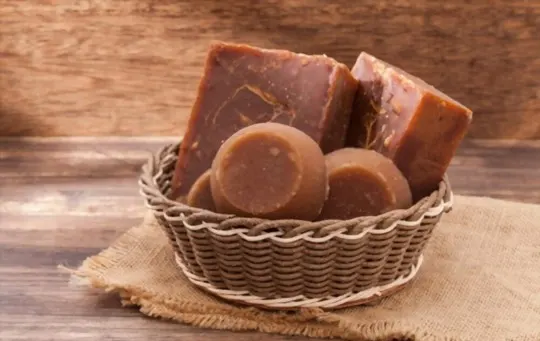
Now coming to the texture and flavor comparison of Jaggery and Palm Sugar.
Both of these sweeteners have distinct textures and flavors.
Jaggery has a grainy texture, while palm sugar is coarse and granular.
When it comes to flavor, jaggery has a strong, earthy taste with a hint of caramel, while palm sugar has a milder flavor with hints of honey.
Jaggery has a rougher texture compared to palm sugar.
The graininess of jaggery makes it perfect for use in Indian sweets as it helps in providing the desired texture.
On the other hand, palm sugar’s coarser texture makes it ideal for use in Thai cuisine where it adds crunchiness to dishes.
Similarly, both sugars have different flavor profiles that can be used for specific purposes.
While jaggery’s strong taste works well in traditional Indian desserts like ladoos or halwas, palm sugar’s mild sweetness makes it better suited for use in Asian cuisines like sauces or marinades.
Nutritional Value
Jaggery and palm sugar are both known for their natural properties and health benefits.
They are unrefined, nutrient-rich sweeteners that have been used for centuries in traditional Indian cuisine.
Both of these natural sweeteners have a significant nutritional value as compared to refined sugar.
As you can see, both jaggery and palm sugar are rich in carbohydrates, which provides us with energy.
Jaggery is much richer in iron than palm sugar while palm sugar offers higher levels of magnesium and potassium.
The presence of vitamin B6 is only found in palm sugar.
Moreover, unlike refined white sugar, jaggery and palm sugars contain essential minerals such as zinc, phosphorus, calcium, copper, and iron.
These minerals perform vital functions such as maintaining good bone health, aiding digestion process and boosting immunity.
Overall, it’s clear that jaggery and palm sugar offer more health benefits than regular refined white sugar.
Culinary Uses and Cooking Differences
Culinary Uses and Cooking Differences: Jaggery and palm sugar may have similar nutritional values, but they have distinct differences in their culinary uses and cooking properties.
When it comes to culinary uses, both jaggery and palm sugar can be used for sweetening purposes, but the type of dish they are best suited for differs.
Jaggery is commonly used in Indian desserts such as laddoos, halwa, and chikki because of its distinctive flavor that complements the ingredients used in these dishes.
On the other hand, palm sugar is preferred in Southeast Asian cuisines like Thai, Indonesian, or Vietnamese where it enhances the aroma of curries, stir-fries, or sauces.
It’s important to note that while jaggery dissolves quickly when added to warm liquids like milk, it may not work as well with acidic ingredients such as lemon juice or vinegar.
In contrast, palm sugar dissolves instantly irrespective of temperature or acidity levels.
Jaggery is usually sold in solid blocks that need to be grated before using while palm sugar comes in crystalline forms.
Due to its crumbly texture, palm sugar can be easily added as a topping on fruits or desserts without melting away easily.
Culinary uses depend on regional preferences too – In South India, jaggery is extensively used as an essential ingredient in traditional cooking.
As the climate is humid, and it helps to overcome fatigue and tiredness.
Likewise, in Southeast Asian countries, palm sugar is an age-old culinary delight that has been passed down through generations.
Similarities Between Jaggery and Palm Sugar
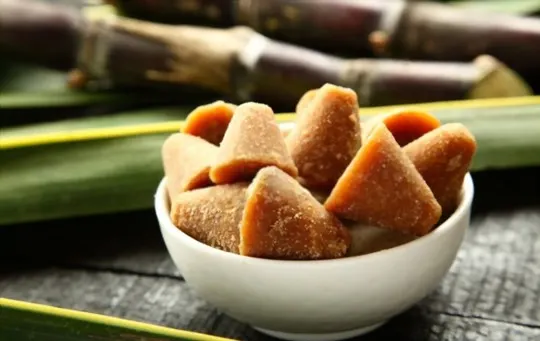
Jaggery and palm sugar are two popular natural sweeteners that are often compared due to their similar properties.
Both jaggery and palm sugar are minimally processed, retaining most of the natural nutrients found in the raw material.
They are also low glycemic index sweeteners, which means they cause a slower rise in blood glucose levels compared to refined sugar.
Apart from this, both have been used for ages as an alternative to white sugar in traditional medicines across different cultures.
In summary, there are several similarities between jaggery and palm sugar such as production methods, flavor, nutrient content and alternative use cases.
This makes them ideal alternatives over regular white sugar.
Which One is Healthier: Jaggery or Palm Sugar?
When it comes to natural sweeteners, both jaggery and palm sugar are popular choices.
However, if you’re wondering which one is healthier, let’s take a closer look at their nutritional profiles.
Both jaggery and palm sugar are quite similar in terms of calorie count and total carbohydrate content.
However, jaggery contains slightly more protein compared to palm sugar.
One of the main benefits of jaggery is its high iron content, which makes it a good option for people with iron deficiency anemia.
Additionally, it has beneficial compounds like antioxidants and phytochemicals that aid digestion.
On the other hand, palm sugar is known to have a lower glycemic index than regular sugar, making it a good alternative for diabetics or anyone concerned about blood sugar levels.
It also contains vitamins B1, B2, B3 and B6.
Overall, both jaggery and palm sugar have their unique health benefits but should be consumed in moderation due to their high carbohydrate content.
Where to Buy Jaggery and Palm Sugar and How to Store Them?
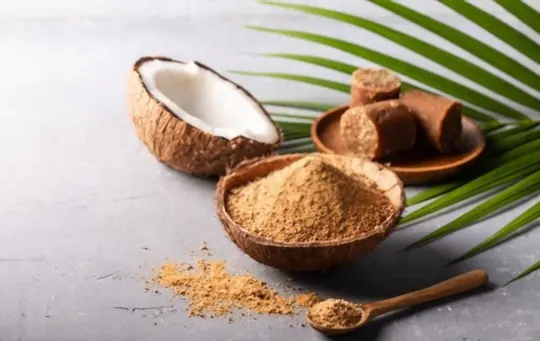
To answer the question of where to buy jaggery and palm sugar and how to store them, both these sweeteners can be easily found in most grocery stores or specialty health food stores.
Jaggery is commonly sold in blocks, while palm sugar may come in crystal or powdered form.
Both sweeteners are also readily available online for purchase.
When it comes to storing jaggery, it should be kept in an airtight container at room temperature away from direct sunlight.
If left exposed to air, jaggery can harden and become difficult to use.
If you live in a humid climate, consider storing it in the refrigerator instead.
Palm sugar should also be stored in an airtight container at room temperature.
To keep your jaggery or palm sugar fresh and free from moisture, you can add some rice grains to the container.
The rice will absorb any excess moisture and prevent clumping.
In terms of recipes, jaggery can be used as a substitute for brown sugar or honey in baking recipes such as cakes, cookies, and breads.
It can also be melted down with water or milk to create a syrup-like consistency for use in desserts or hot drinks.
Palm sugar can similarly be used as a substitute for brown sugar in cooking and baking recipes.
Overall, both jaggery and palm sugar offer unique health benefits and distinct flavors that make them excellent alternatives to refined white sugar.
By understanding where to buy these sweeteners and how best to store them, you can enjoy their natural sweetness and health benefits without any added fuss or hassle.
Conclusion
Based on the comparison of jaggery and palm sugar, it can be concluded that both sweeteners have their own set of benefits and drawbacks.
Ultimately, the choice between the two comes down to personal preference and dietary requirements.
When considering taste, jaggery has a characteristic molasses-like flavour which may not suit everyone’s palate.
On the other hand, palm sugar has a mild caramel flavour that blends well with various dishes.
Ultimately, both sweeteners have uses for cooking as well as natural remedies due to their nutritional content.
When choosing between jaggery and palm sugar, consider individual needs such as flavor preference or dietary restrictions like blood sugar control.
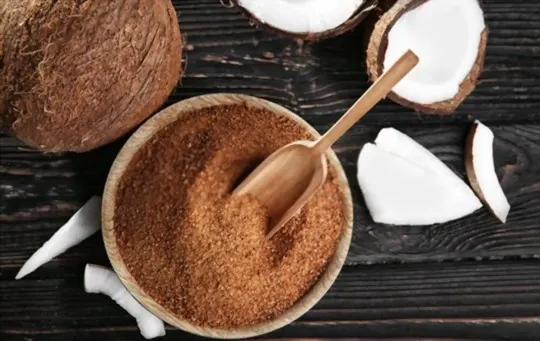
Jaggery vs Palm Sugar: What’s the Difference?
Ingredients
- Jaggery
- Palm Sugar
Instructions
- Choose between two items based on your preference and availability.
- Follow the cooking directions for your chosen option, using the appropriate ratio of ingredients.
- Prepare it according to your desired recipes.
- Incorporate them into your dish, adjusting the amount to suit your taste.
- Enjoy the unique taste experience and experiment with different dishes to explore their versatility.

Andrew Gray is a seasoned food writer and blogger with a wealth of experience in the restaurant and catering industries. With a passion for all things delicious, Andrew has honed his culinary expertise through his work as a personal chef and caterer.
His love for food led him to venture into food writing, where he has contributed to various online publications, sharing his knowledge and insights on the culinary world. As the proud owner of AmericasRestaurant.com, Andrew covers a wide range of topics, including recipes, restaurant reviews, product recommendations, and culinary tips.
Through his website, he aims to inspire and educate fellow food enthusiasts, offering a comprehensive resource for all things food-related.

Leave a comment